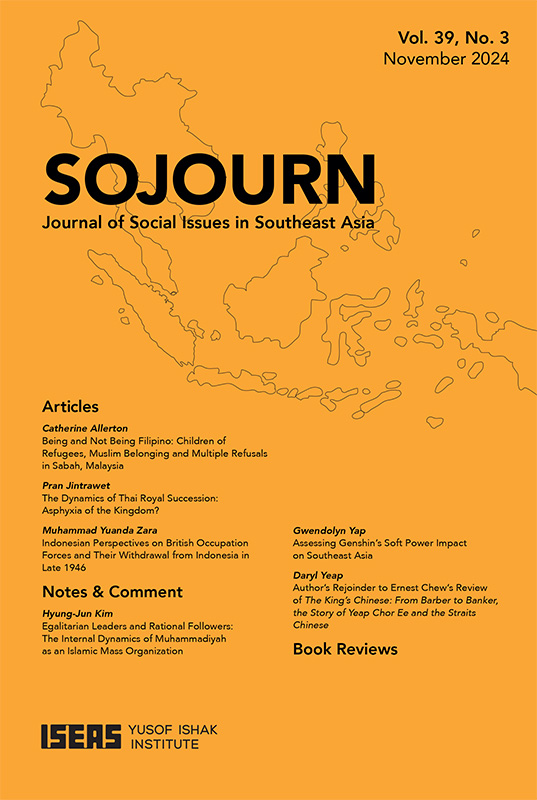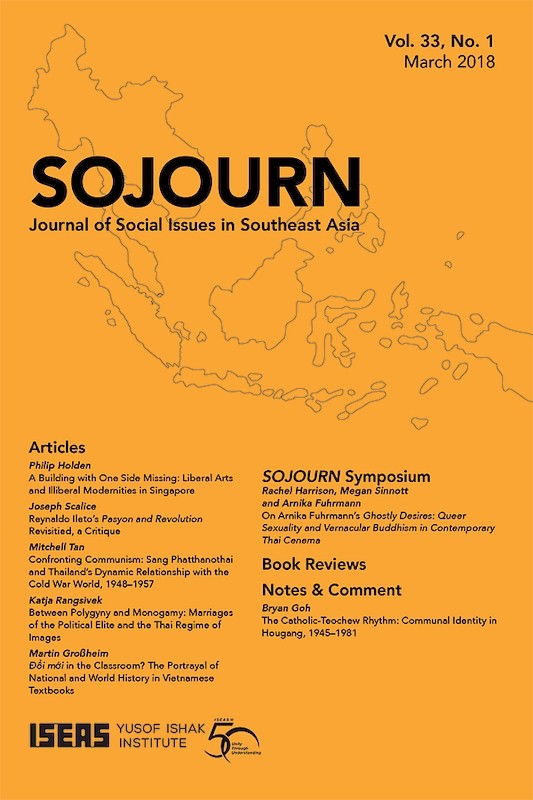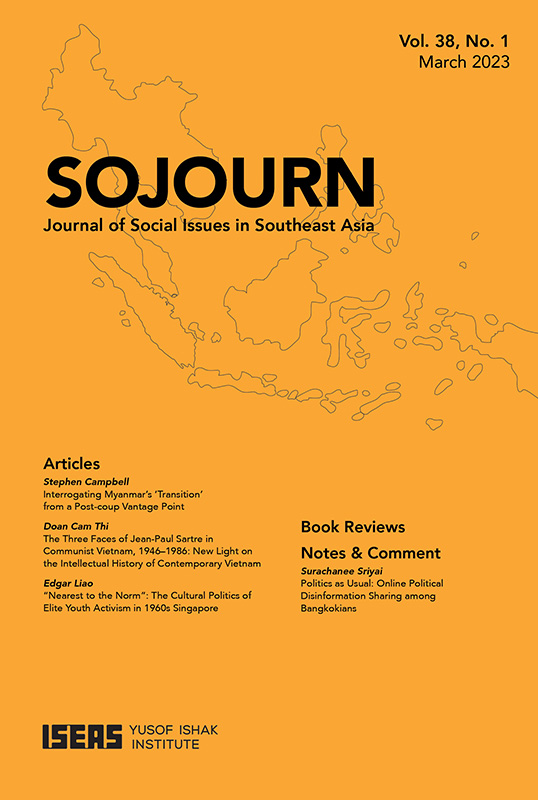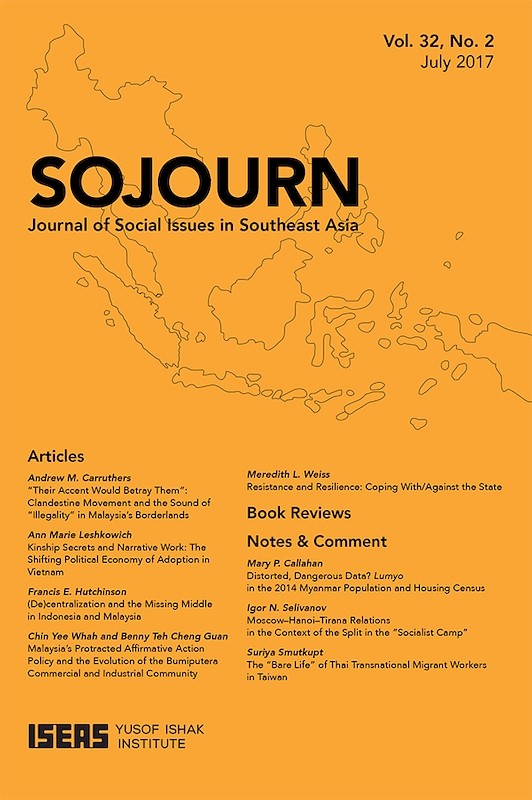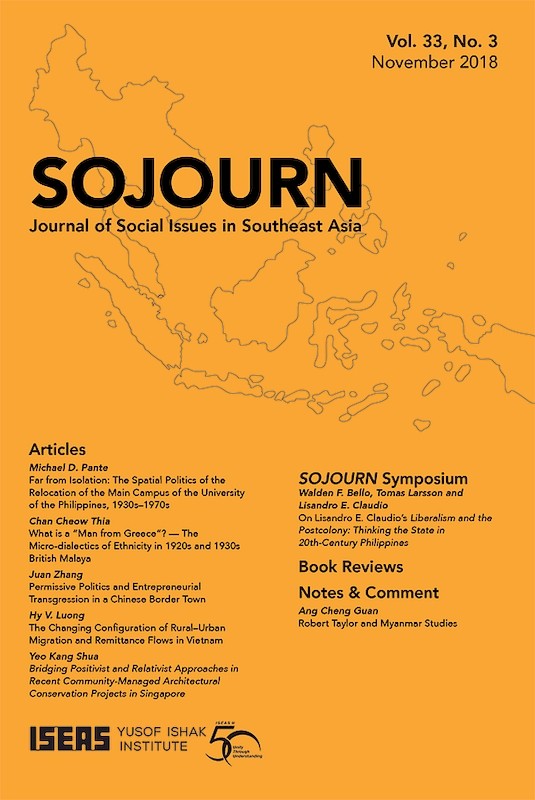SOJOURN: Journal of Social Issues in Southeast Asia Vol. 36/1 (March 2021)

Su-Ann Oh, editor
Date of publication:
February 2021
Publisher:
ISEAS – Yusof Ishak Institute
Number of pages:
200
Code:
SJ36/1
Contents
-
SOJOURN: Journal of Social Issues in Southeast Asia Vol. 36/1 (March 2021)
[Whole Publication, ISSN: 17932858] -
Preliminary pages
- ARTICLES
-
1. “We are Siding with Filipino Capitalists”: Nationalism and the Political Maturation of Jose Ma. Sison, 1959–61, by Joseph Scalice, author see abstractJose Maria Sison, founder of the Communist Party of the Philippines, developed the foundational ideas of his future political career during his final year as a graduate student at the University of the Philippines in 1961. An examination of his writings and activity over the course of this year reveals that a series of political developments pushed his ideas from those of an existentialist focused on the alienation of the individual to the basic conceptions of Stalinism, which sought to tie mass social anger to the interests of a section of the ruling class in the name of nationalism.
-
2. Expressions of the Self in Vietnam: Usage of ‘I’ throughout Literature in nôm and in quốc ngữ, by Doan Cam Thi, author see abstractThe modern Western world as the matrix for the individual has been a widely accepted theory among the general public as well as in the areas of social and human sciences. Recently, however, extensive work in various fields—linguistics, literature, history, philosophy and anthropology—has adopted a new approach to research in areas beyond simplistic Western ideas based on binary distinctions; for instance, individualism versus holism, or the West versus the Orient. This paper aims to contribute to this new area of research by offering an overview of the development of the Self and the linguistic manifestations of ‘I’ in Vietnamese literary works.
-
3. Why Did They Rise Up? The Local Reality of the Farmers’ Movement in 1970s Thailand, by Shinichi Shigetomi, author see abstractIn mid-1970s Thailand, an intense farmers’ movement gathered pace. This study focuses on this village-level movement and investigates why and how farmers took the risk of protesting. It finds that the movement was organized by small groups of villagers or through networks of individuals rather than a wide-ranging mobilization of underprivileged farmers. The villagers’ sense of justice, and not merely their economic grievances, led them to rise up in protest. Taking the case of the northern and central regions, the movement should be regarded as a combination of different organizational structures and strategies rather than a unified national movement.
-
4. Islamic Finance as an Ethno-political Agenda in the 1980s: An Inquiry into the Role of Islamic Finance Pioneers, by Hideki Kitamura, author see abstractThe inextricable relationship between state policies and the progressive development of Islamic finance in Malaysia has long been a subject of study. However, few studies have explored the role the pioneers of Islamic finance played. This study reveals that the pioneers considered the sociopolitical significance of the success of Islamic finance and therefore sought to establish efficient operations that were comparable to those of conventional finance. With these findings, I contend that the symbolic role of the pioneers is substantially more significant than any economic effect they had.
-
5. From Armed Revolution to Neutralism: China and the Indochinese Revolution in Laos, 1950–54, by Shu Quanzhi, author see abstractThe post-1949 years were a crucial stage of the First Indochinese War.The People’s Republic of China entered the fray, greatly intensifying the conflict and drawing Indochina into the Cold War while Indochinese Communist Party leaders readjusted their anti-colonial apparatus. The Indochinese character of the struggle was more noticeable, and China gave its full support by pushing the Vietnamese to expand their fight into Laos between 1952 and 1954. They even advocated, together with the Vietnamese, for the communist vision of Indochina at Geneva. However, faced with staunch rejection by the West and a weak anticolonial movement in Laos, the Chinese shifted from supporting armed revolution to advocating neutralism.
- SOJOURN Symposium
-
On Wayang and Its Doubles: Javanese Puppet, Theatre, Television and the Internet by Jan Mrázek, by Marianna Lis, Ward Keeler, Jan Mrázek, authors
- BOOK REVIEWS
-
BOOK REVIEW: Southeast Asia after the Cold War: A Contemporary History, by Ang Cheng Guan, by Matthew Jagel, author
-
BOOK REVIEW: The Politics of Vietnamese Craft: American Diplomacy and Domestication, by Jennifer Way, by Kathleen Ditzig, author
-
BOOK REVIEW: The Crown and the Capitalists: The Ethnic Chinese and the Founding of the Thai Nation, by Wasana Wongsurawat, by Guo-Quan Seng, author
-
BOOK REVIEW: Identity, Nationhood and State-Building in Malaysia, by K.J. Ratnam, by Shamsul A B, author
-
BOOK REVIEW: Southeast Asia’s Modern Architecture: Questions of Translation, Epistemology and Power, edited by Jiat-Hwee Chang and Imran bin Tajudeen, by Pauline K. M van Roosmalen, author
-
BOOK REVIEW: Hearing Southeast Asia: Sounds of Hierarchy and Power in Context, edited by Nathan Porath, by Sarah Weiss, author
-
BOOK REVIEW: Angkor Wat – A Transcultural History of Heritage, vol. 1, Angkor in France: From Plaster Casts to Exhibition Pavilions, vol. 2, Angkor in Cambodia: From Jungle Find to Global Icon, by Michael Falser, by Károly Belényesy, Csilla Kőfalvi, authors
-
BOOK REVIEW: Defining Dvāravatī, edited by Anna Bennett and Hunter Watson, by Stephen Murphy, author

